| A Simple But Effective Low-Band Base Antenna | |
Since childhood I have been in search of the best performance out of an antenna. It began with my first folded dipole hung between a tree and the house. Later I fashioned coils and inserted them inline to increase the electrical length of the antenna. My love for building antennas has grown ever since. Back in the 70's the Los Angeles County Sheriff was still on low band at 39mHz and I knew from experience that a CB antenna worked great when tuned just by shortening the radiator. Propagation of low band signals is great, including "skip." But here at my new home in Big Bear, California -- where birds sing and the skies are blue -- I didn't want to have an antenna farm on the roof. This meant a vertical antenna without ground radials. The Half-Wave Coaxial Antenna An effective emergency antenna used by many amateur radio operators is fashioned by making a 1/2 wave antenna using coaxial cable. This is done by pulling the braid back 1/4 wave length over the cable insulation. You may then tack the center conductor up on a wall and plug into a scanner. Although it works, this isn't a permanent antenna. Enter the home-made, full-size solution. Some of you may recognize this as the type of antenna that CHP uses. Yep. | |
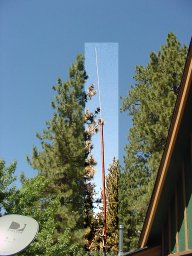 | This version is tuned for 40mHz and stands 11.3 feet tall. Made from schedule L and M copper pipe, this version is better able to withstand high winds. Using an antenna analyzer shows a 1:1 SWR. Perfectly tuned! |
| Construction | |
Construction of this antenna is very straight-forward and requires only a few inexpensive parts.
| 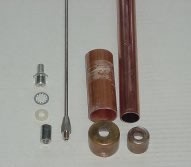 |
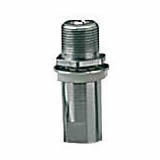 | Begin first by drilling out the copper end-caps to accept the feed-thru adapter from radio Shack. The adapter comes apart to expose a slightly raised and electrically shielded 3/8" stud. When drilling the caps make every effort to drill the holes in the exact center of the caps. This will allow a uniform distance from the pipe when finally attached. Slip the smaller cap into the larger cap and affix the 3/8" feed-thru adapter. |
 |  |
Now that the end-caps have been prepared you will need to cut the copper pipes to length. The 1" pipe needs to be cut to 86" A pipe cutter or hacksaw will work fine. The 1 1/2" pipe will be cut to 68". Once this has been done you are ready to assemble the antenna. Simply insert the 1" pipe into the 1 1/2" pipe. Slip your quality RG-8 or better coax into the 1" pipe and feed it up to the other end. Make sure that you have no burs or sharp edges from cutting either pipe. NOTE: This antenna can be cut for the 6 meter amateur radio band and makes an excellent repeater antenna. The formula for the elements is ((460/f) / 2) where f is the frequency. At high elevations it works better without a ground plane. At lower elevations you may add a 1/4 ground plane below the sleeve and achieve about 3dB gain. Bob - AF6D | |
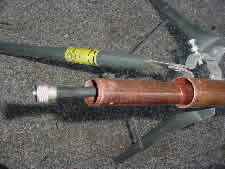 | Once this has been done you are ready to assemble the antenna. Simply insert the 1" pipe into the 1 1/2" pipe. Slip your quality RG-8 or better coax into the 1" pipe and feed it up to the other end. Again, make sure that you have no burs or sharp edges from cutting either pipe. |
Next, we need to use quality duct tape at the bottom of the 1" pipe. Measure 17" up from the bottom and begin wrapping 2" wide duct tape around the pipe until it is about 3/8" thick or so -- just thick enough so that when the 1 1/2" pipe is pulled over it it is snug and electrically insulates. Just above this wrap make an identical wrap so that you have about 4" of duct tape. As an option you may use wrap-around weather sealing foam tubes. |  |
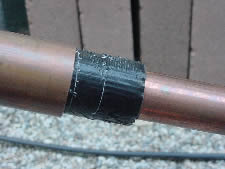 | We are now ready to slide everything together. Grab your end-cap assembly and snuggly attach the PL-259 connector on your cable to the SO-239 socket on the feed-thru adapter. Make a good, solid connection. You probably don't need to worry about trying to put tape around it. |
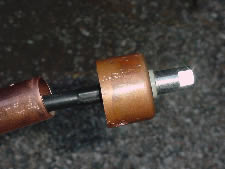 | |
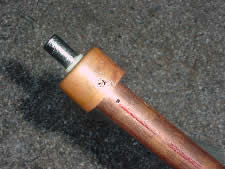 | Next, slip the 1" pipe up into the 1" end-cap. Then slip the 1 1/2" pipe up into the outer 1 1/2" end-cap. Note in the photo that we have drilled a small hole. This hole is drilled so that it goes through both end-caps. It should be just large enough to start a 1/2" self-tapping sheet metal screw. This screw will then be tightened down. Once tightened, it will just touch the outer ring of the PL-295 connector inside the pipe. This will ensure solid electrical contact all the way through. |
Finally, take the 102" CB whip antenna and cut it down to 68". Once cut, attach it to the top of the feed-thru adapter. You are now ready to put your stick in the air! |  |
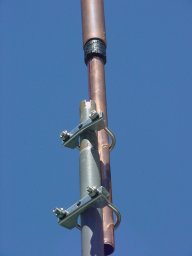 | The last steps require that you use mounting hardware sufficient to mount this antenna to a vertical pipe. Your situation will determine what you use. I used 2 1/2" muffler clamps and attached the antenna to a 10 foot push-up. Do not over-tighten the clamps because the copper pipe will collapse. In fact, better clamps to have used would have beenTV mast type because of the way that they wrap around with teeth. The absolute final step for me was to use non-conductive paint and spray the entire antenna a nice shade of green to match my mountain community home. Choose a color that you like and spray -- this is copper and needs to be covered. This design is the heavy-duty design and should provide years of unattended reception in even the harshest weather. This antenna is on its 5th winter at 7,000 feet up in snow country. Happy monitoring! Bob Ricci - AF6D |
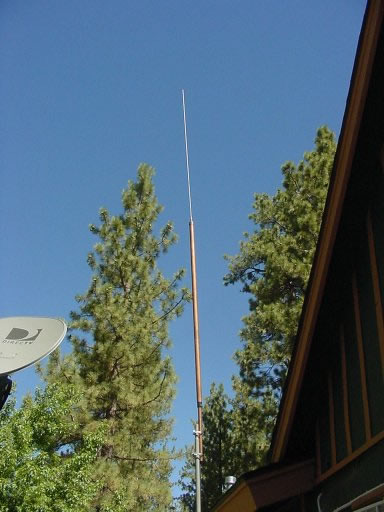 | |
Saturday, February 25, 2012
A Simple But Effective Low-Band Base Antenna
Subscribe to:
Post Comments (Atom)

No comments:
Post a Comment